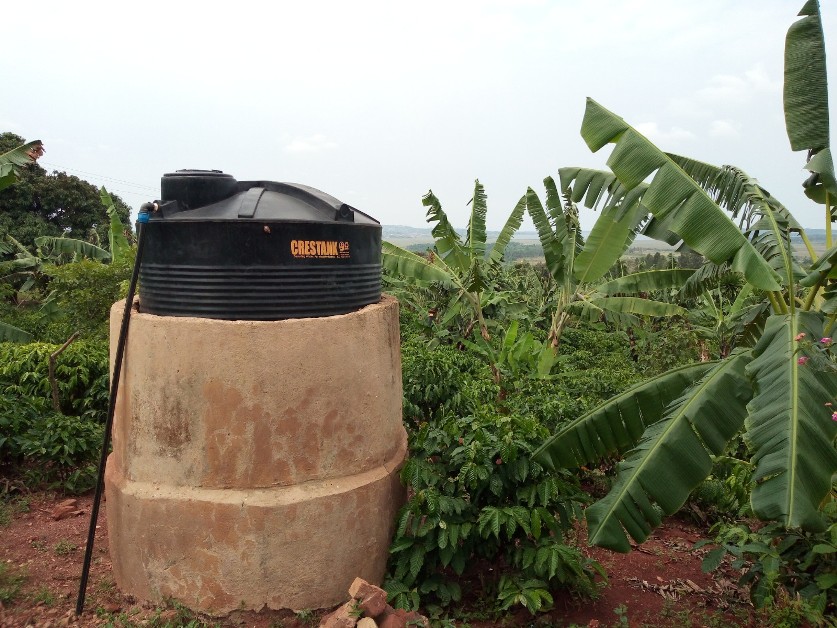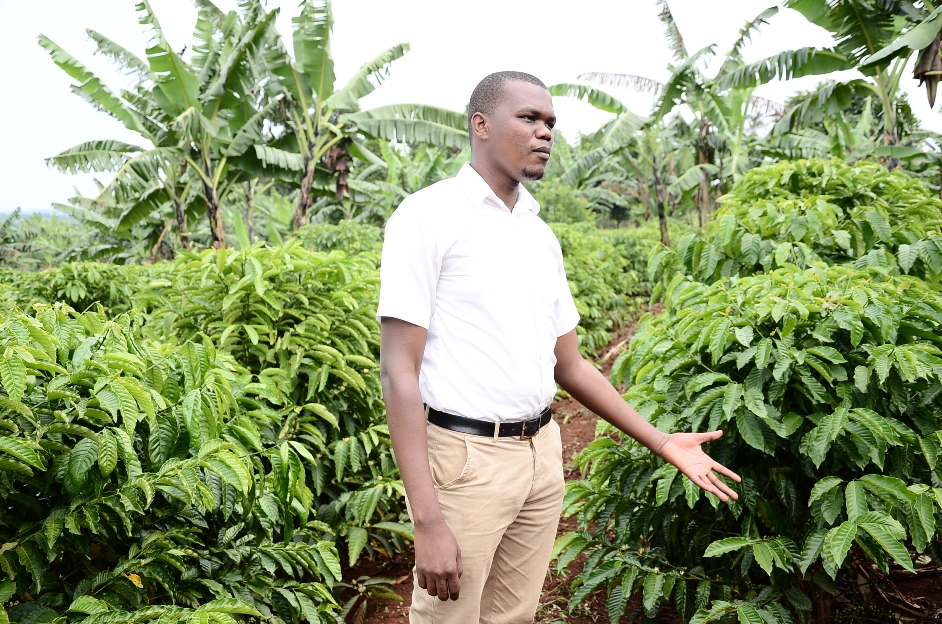Johnbosco Sebabi, the Head Teacher at St. Mary’s SS Kitende has set his eyes on coffee farming
The COVID-19 pandemic has affected the entire world but teachers are one of the groups that have been hit most by the deadly disease.
Indeed, one of the key lessons the disease has taught salaried workers is that depending on a single source of income is suicidal.
Nonetheless, there are a few salaried employees that are worth emulating.
Johnbosco Sebabi, the Head Teacher at St. Mary’s SS Kitende (A Level section) is a one shining example to teachers in Uganda and the world at large that investing your hard-earned money in other enterprises is worth it.
Sebabi chose farming and coffee in particular as his main enterprise.
His well kept and young coffee plantation is intercropped with matooke/bananas which give him food and some money as he waits to have his first harvest from coffee.
“Much as we are suffering as teachers, I don’t buy matooke,” Sebabi says in an interview with Business Focus at his 3-acre farm located in Ngologolo village, Kajjansi Town Council, Wakiso District- approximately 6 kilometers off Entebbe road.
Why Coffee
Born 47 years ago in Nsotoka village in Kayunga district in a peasant family, Sebabi, a Geography teacher with over 20 years experience in teaching says his father used to grow coffee on a small scale but it gave them a decent living.
“Although it was on a small scale, income from it helped us to get school fees and other basic needs,” he says, adding that during harvest time, they (children) would pick the ripe coffee berries and dry it.
“Our home was also near a coffee processing plant that was employing many people. So I picked interest in coffee,” he says.
ALSO READ:
How To Earn Over Shs23m From An Acre Of Coffee Annually
Lessons For Farmers From Africa’s Largest Coffee Plantation
MAGIC IS IN SPACING; Ex-Seminarian Explains How To Earn Millions From Coffee Farming
Having attained a Bachelor’s Degree in Education from Makerere University several years ago, Sebabi embarked on teaching and therefore never saw himself as a farmer-at least in the near future.
However, out of his savings, he bought about three acres of land in 2016 in Ngologolo village (Wakiso district).
At the time, he didn’t have a clear plan on how to develop the land.
Sebabi says in 2018 he chanced on an article where Center For Agribusiness & Farmer Entrepreneur Enhancement (NUCAFE) Executive Director, Joseph Nkandu had adopted a new system of coffee farming dubbed Brazilian style, where people with small pieces of land would earn big from the world’s second most traded item.
The new system involves spacing coffee at one meter from one plant to another and three meters between rows (1m*3m).
Unlike the 3*3m spacing currently recommended by Uganda Coffee Development Authority (UCDA) where a farmer will have a maximum of 450 plants in an acre, under the Brazilian style (1m*3m spacing), a farmer can have as high as 1,300 coffee plants in the same space.

Curious to know more about this style of coffee farming, Sebabi and his wife-Margret Birungi visited Nkandu’s one-acre demonstration garden in Bunjakko Island, Buwama Sub-county, Mpigi District.
“I wondered if I can plant more than 1,000 trees in an acre, why not try it out?” says the soft-spoken teacher and Administrator.
He adds that back in the days coffee spacing was wide up to 15ft by 15ft.
Not to make mistakes, Sebabi made a second visit to Nkandu’s demonstration garden and this time around, he was convinced that the 1m*3m spacing was ideal for coffee farming.
“According to Nkandu’s explanation, coffee extracts nutrients from within the spaces. The same applies to sunlight and we have seen it happen here,” he says.
Soil testing key
Sebabi reveals that before planting the coffee, he was advised to first carryout soil testing and analysis.
“The results were not encouraging,” he says, adding that he was advised to apply lime, organic manure and do mulching thereafter if he was to get the best out of coffee.
In October 2018, he planted his first batch of about two acres. He planted Clonal coffee plantlets of the first/old line. He has since expanded to have three acres with over 3,000 trees.
At two years (October this year), he will start harvesting some little money but come next year (at three years), he will begin to realize good harvests since the trees have now grown bigger and are set to flower either at the end of 2020 or early next year.
Sebabi says to boost growth of the young coffee plants, he applied a basin of organic manure (cow dung and chicken droppings) on each hole. He also regularly applies artificial fertilizers.
Like other farmers embracing the Brazilian style, Sebabi says this system is very good and effective if a farmer is applying some sort of irrigation as well as manure/fertilizers.

He has also put some ridges in the plantation to control soil erosion and ensure soil retention considering the topography of the area.
Cutting Costs
Sebabi employs two workers. However, their payment isn’t a big problem because the matooke that is intercropped with coffee helps him to offset the cost.
“They also feed on matooke,” he says, adding that he has also built a pig sty to embark on piggery farming. This, he says, will help him save on the money spent on buying manure.
“I now days spend less on this project as I did at the beginning,” he says, adding: “With coffee, you can’t go wrong because market is always available.”

Challenges
He says he doesn’t have a permanent source of water. “The one I have was enough when coffee was still young, but now it’s not enough. Water gets consumed before the whole plantation is covered,” he says.
He adds: “Because the coffee is close to each other, water intake is high and if you don’t irrigate, yields may go down.”
He adds that Coffee Twig Borer is also a big challenge. However, he has managed it by cutting off and burning the affected branches/clusters as well as regularly spraying with pesticides.
Sebabi adds that farming needs the attention of the farmer because leaving it to workers is too risky. He gives an example of his workers who were weeding the coffee while ignorantly digging deep and cutting the roots in the process.
“The roots are on the surface and thus there was no need for them to dig deep. If I had taken long without coming here, they could have caused much damage,” he says, adding that he works with the wife to ensure that the project is well monitored.
Planning Early For Retirement
Although he is not retiring soon, Sebabi says when time for retirement comes, there’s no doubt he will settle into farming.
“Teaching needs when you’re still active. For now, I’ll continue teaching and doing farming at the same time,” he says, adding: “When I retire, I will expand my coffee project.”
Asked about his projected output come next year when his coffee is fully grown up, Sebabi says he can only cross the river when he reaches it.
He however says even if he got a minimum of a kilogram of FAQ (Fair Average Quality) commonly referred to as Kasse from a tree per season, he wouldn’t make a loss. With over 3,000 trees, this would translate into 3,000kgs (3 tones). With an average price of Shs4, 000 per kilogram of FAQ, Sebabi will be earning a minimum gross profit of Shs12m in a season. There are two coffee seasons in a year.

He reveals that he will apply the best agronomic practices to ensure that his farm becomes a demonstration centre for other farmers.
“We want to make this project as modern as possible for agri-tourism purposes,” Sebabi says.
Expert’s Take
Ronald Onyangai, the Production Officer at NUCAFE explained why every farmer should carry out soil testing before planting any crop.
“It helps you know nutrients that are available in the soil tagging to the plant nutrient requirements,” he says, adding that some areas have acidic soils that don’t favour growth of some plants.
With soil testing and analysis, he says, one is able to know what exactly is missing in his soil and apply it for better growth of crops.
I also asked him whether the 1m*3m spacing doesn’t affect cup quality.

In response, Onyangai says this method can produce “the best cup quality because of good management.”
“Under this method, you are guaranteed of the best grate. The better the grade, the better the cup quality,” he says.
Onyangai says under best agronomic prices, one can have 3-5 kilograms of FAQ (Fair Average Quality) commonly known as Kasse per tree. With over an average of 3 kilograms of FAQ, a farmer like Sebabi with over 3,000 trees would be able to get over 9,000 kiolgrams (9 tones) from three acres.
Taking an average of Shs4,000 per kilogram of FAQ, it means that a farmer will earn over Shs36M gross profit from the 9,000 kilograms harvested in a single season.
“Prices for FAQ vary depending on grade. Each grade attracts a different price,” Onyangai says.
Uganda’s Coffee Production On Rise
Uganda’s coffee exports reached a record high in the Financial Year 2019/20 after 5,103,771-60 kilo bags worth US$496 million (UShs1.8 trillion) were exported compared to 4,168,408-60 kilo bags worth US$415 million (UShs1.52 trillion) the previous year, according to figures from Uganda Coffee Development Authority (UCDA).
A few years ago Government embarked on a plan of increasing coffee production to 20m-60kg bags by 2025.
The author is a farming journalist. For quality Clonal Coffee Planting materials and consultancy, contact me via 0775170346/ 0703828741/ staddewo@gmail.com







Thanks for the information well analyzed. I personally love agriculture. Can you guide me on the best type of coffee to be planted in Arua district?
Robusta. For more info, call me via: 0775170346/0703828741
Best analysis ever gotten. Hope to plant Tomatoes in Mbale for December, January and mid February Market but i dont know when to start nursery? secondly advise me on the best type
I like the idea of the spacing of three meters
Like for my region in Gulu city Robusta is the best due to our weather
I believe in farming with all my heart as a youth coffee is the right thing to do due to its ready market
Thanks, Taddewo. The analysis and reporting is pretty superb and practical…No sugar coating unlike other reporters.
Please keep keeping us in the know.
Very exciting experience here. Coffee farming is the way to go if you must plan for your retirement. Its about setting the mind to start and whenever someone is ready to start, am available to supply the required materials. Am an accredited nursery operator located in wakiso serinya village only 150metres off Hoima road. Interested clients can contact us on 0772459126/ 0703850091